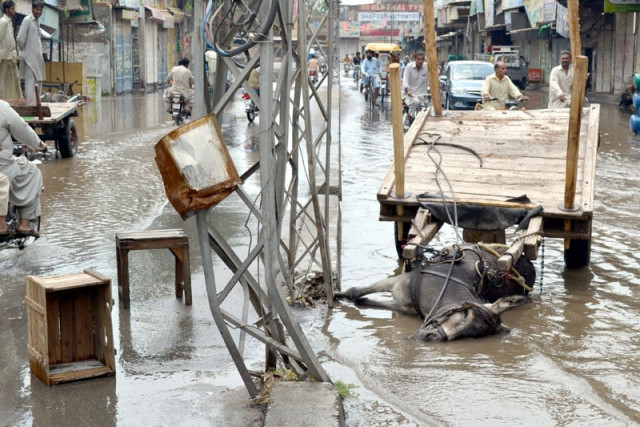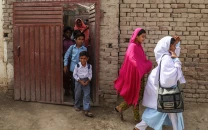Torrential rains kill 21 in south Sindh
Mirpurkhas worst affected with 15 people being killed in torrential rains.

Torrential rains kill 21 in south Sindh
"At least 21 people died, most of them because of falling roofs during rains on Thursday night," said Sajjad Haider Shah, an official at the disaster management authority in the southern province of Sindh.
Of the dead, 15 occurred in Mirpurkhas district, which was the worst-affected, he told AFP.
"The rains have also destroyed crops and forced hundreds of people to leave their homes," said Shah.
The meteorological office forecast more rains for this week.
Last year, the worst floods in Pakistani history affected 21 million people and killed another 1,750. Charities accuse Pakistan of since failing to invest in prevention measures
updated from the print edition below.
Renewed crop damage: As rain comes down, people take to their heels
The heavy monsoon downpour in Badin has so far dislodged tens of thousands of people from their homes.
The two-day burst, which subsided by Thursday night, also played havoc with crops as around 125,000 acres of cotton, rice, sugarcane, spices and other crops are in peril of destruction.
According to Badin DCO Kazim Hussain Jatoi, more than 5,000 rain-displaced people have been given shelter in 58 camps set up in schools. However, the private estimates vary. “Up to 15,000 people have been displaced in Golarchi tehsil alone,” said Javed Bhatti, who is the executive director of the Jago Development Foundation, whose NGO is beginning to start relief work.
Badin received more than 300 millimetres by Thursday evening. “The affected tehsils have an estimated population of between 600,000 and 700,000,” said official Dadlo Zohrani while talking to The Express Tribune.
Badin district is surrounded by more than twelve drains, including the major Left Bank Outfall Drain (LBOD), which carry waste water towards the sea.
By Friday morning, at least 25 breaches developed in two fresh water supply systems and five drains, a local journalist said. “The rainwater along with that spilling out from the drains, canals and distributaries swamped over 200 villages,” Malik Ilyas said. The biggest each have between 1,000 and 5,000 dwellers, he added.
The road network with Badin’s coastal villages, that are inhabited by tens of thousands of people, have been completely disconnected. Also submerged are graveyards, including the historic Shah Qadri graveyard, railway lines, intercity roads and the 30-kilometre link road between Golarchi and Badin tehsils.
The district government began frantic work, albeit two days late, by Friday evening by distributing cooked food in some camps. “The funds frozen after the introduction of the commissionerate system were released today after our accounts were reactivated,” said DCO Kazim Hussain Jatoi.
The NGOs have planned to start work Saturday. “We are working out how much is needed to serve the affected people,” said Asghar Laghari, general manager the Larr Humanitarian and Development Foundation. For Laghari, the government’s figures are misleading. “We are trying on our own to figure out the actual number.” The people taking refuge in camps is just a fraction of those who have moved out as most of them prefer to stay with their relatives and friends, he added.
Even if it did not rain, the deluged areas are likely to remain under water for another four or five days because of high tidal waves which will continue till the 20th of the moon. However, the meteorological department has forecast another three days of rain and thunderstorm starting from Saturday. “In all likelihood, we think worst is yet to come,” cautions Javed Bhatti, citing squalid condition of the relief camps.
He predicts an outbreak of diarrhea, malaria and skin diseases in the ensuing days. “People are living in filthy conditions. They have only one or two toilets for 500 or more people in the relief camps. And, even the NGOs are unable to provide clean water due to the grave circumstances.”
Crops
Growers fear complete devastation of their cotton crop over more than 70,000 acres in Badin. “The produce of each acre is sold at over Rs75,000,” tells Haji Nawaz Memon while referring to the magnitude of the loss.
According to Memon, who is the Badin president of the Sindh Abadgar Board, crops of rice, tomato, sugarcane and spices will also be damaged. “A cotton field can withstand accumulated water for two to three days but spices can’t hold out for longer than a day.”
The board estimates a 25 to 30 per cent loss to the sugarcane crop cultivated over 100,000 acres, complete destruction of around 30,000 acres of spices and half the harvest of the paddy standing on 90,000 acres.
Published in The Express Tribune, August 13th, 2011.
For pictures of the monsoon rain, view slideshow here



















COMMENTS
Comments are moderated and generally will be posted if they are on-topic and not abusive.
For more information, please see our Comments FAQ